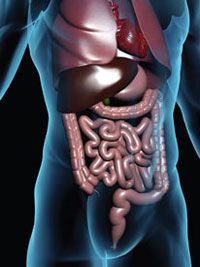Article
Oxaliplatin Treatment Duration Potentially Linked With Incidence of Severe Neuropathy in Stage III Colon Cancer
Author(s):
Patients with stage III colon cancer who receive longer courses of adjuvant oxaliplatin, exercise for less than 9 hours per week, have diabetes, or have a higher body mass index could experience higher rates of severe oxaliplatin-induced peripheral neuropathy.

Patients with stage III colon cancer who receive longer courses of adjuvant oxaliplatin, exercise for less than 9 hours per week, have diabetes, or have a higher body mass index (BMI) could experience higher rates of severe oxaliplatin-induced peripheral neuropathy (OIPN), according to findings from the observational CALGB/SWOG 80702 trial published in the Journal of Clinical Oncology.
Notably, neither the duration of celecoxib (Celebrex) treatment nor vitamin B6 intake were linked to the severity of OIPN.
Patients who underwent 12 treatment cycles vs 6 cycles of oxaliplatin-based chemotherapy were 4 times more likely to experience a higher grade of Common Terminology Criteria for Adverse Events (CTCAE)-reported neuropathy both during treatment (odds ratio [OR], 4.4; 95% CI, 3.72-5.14; P < .001) and following treatment (adjusted OR, 3.76; 95% CI, 3.20-4.42; P < .001). The rate of severe Functional Assessment of Cancer Therapy/Gynecologic Oncology Group – Neurotoxicity (FACT-GOG-NTX)-reported neuropathy was also higher with the 12-treatment-cycle group (adjusted difference in means, –5.0; 95% CI, –6.0 to –4.0; P < .001). A longer time to neuropathy resolution was reported for the 12-cycle group (median, 14 months; IQR, 8-27) vs patients who underwent 6 treatment cycles (median, 9 months; IQR, 3-17.5).
Those who exercised for more than 9 hours per week demonstrated improvement OPIN scores (mean score, 43.2) compared with those who exercised for less than 9 hours (mean score, 41.3; adjusted difference, 1.47; 95% CI, 0.49-2.45; P = .003). However, this association was deemed nonsignificant during both treatment and follow-up.
Patients who had a BMI 25 or greater were also more likely to experience OIPN compared with those with a BMI less than 25 both during treatment (OR, 1.18; 95% CI, 1.01-1.50; P = .05) and following treatment (OR, 1.23; 95% CI, 1.01-1.50; P = .04). For individuals with diabetes, a history of the comorbidity likened to worse neuropathy (adjusted difference in means, –2.0; 95% CI, –3.3 to –0.73; P = .002).
According to study authors, more than 90% of patients with colorectal cancer who receive oxaliplatin may develop OIPN, which can affect daily functioning, mental health, and quality of life. Moreover, as the survivorship population in this setting continues to grow, so does the need for better tools to effectively manage this toxicity. The study authors noted that in addition to the findings from this observational study, findings from an ongoing randomized phase 2/3 trial (NCT04137107) evaluating the use of duloxetine as OIPN prophylaxis in patients with colorectal cancer this may offer potential treatment direction guidance.
“Shorter chemotherapy durations in the management of [colorectal cancer] have been shown to be similarly effective as longer treatments, and our findings lend support for potential additional benefits through decreased chemotherapy-related toxicity and improved treatment adherence and quality of life,” wrote Seohyuk Lee, BSc, a medical student at Yale University, and coinvestigators, in the study. “Our study highlights the need to more effectively identify, monitor, and manage the various patient and treatment risk factors associated with increased OIPN.”
The prospective cohort study included patients from both the United States and Canada who were participating in the National Cancer Institute-sponsored Cancer and Leukemia Group B /Southwest Oncology Group 80702 adjuvant therapy trial for stage III colon cancer (NCT01150045). The primary objective of the trial was to assess whether celecoxib would outperform placebo in improving disease-free survival, and the secondary objective was to assess whether 3 months (6 treatment cycles) or 6 months (12 treatment cycles) of adjuvant FOLFOX (oxaliplatin, leucovorin calcium, and fluorouracil)chemotherapy was the optimal treatment length. Other secondary objectives included curating a toxicity profile of the agents and assessing overall survival with celecoxib. Patients were asked to complete a self-administered questionnaire querying about dietary and lifestyle behaviors both at 6 months into adjuvant therapy and again 14 to 16 months following random assignment.
All participants had had histologically documented, marginal-negative resected colon adenocarcinoma, and had tumors harboring at least 1 pathologically confirmed positive lymph node or an N1C designation. Both the assignments detailed a patient’s physical activity level, BMI status, diabetes history, and vitamin B6 intake. BMI was also assessed at the treatment sites prior to treatment.
Two different patient-reported instruments were leveraged to assess neuropathy: the CTCAE version 4.0 and the FACT/GOG-NTX-13 subscale. Once patients-initiated chemotherapy, they were screened for neuropathy every 3 months for 3 years. Following random assignment to adjuvant regimen, they were assessed every 6 months for 6 years, or until disease recurrence, whichever came first.
Investigators noted that patients who were randomly assigned to 12 treatment cycles vs 6 cycles were consequently more likely to have a proximal tumor, engage in less physical activity, and receive a higher dose of oxaliplatin.
Ultimately, 99.8% of patients had at least 1 CTCAE-reported neuropathy measurement during treatment and 96.3% had a CTCAE assessment following treatment. A total of 1242 patients completed the FACT/GOG-NTX-13 neurotoxicity measure.
There were no significant differences over time in CTCAE-reported neuropathy and FACT/GOG-NTX-13 reported neuropathy by celecoxib treatment. The rates of CTCAE-reported neuropathy and FACT/GOG-NTX-13-reported neuropathy were also similar between patients with below median or median vitamin B6 intake.
Reference
Lee S, Ma C, Shi Q, et al. Potential mediators of oxaliplatin-induced peripheral neuropathy from adjuvant therapy in stage III colon cancer: findings from CALGB (Alliance)/SWOG 80702. J Clin Oncol. Published online November 11, 2022. doi:10.1200/JCO.22.01637









